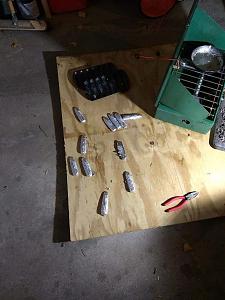I couldn't find exactly the right sub for this so I posted it here. Mods - if there was a better place let me know.
I bought the following items to start casting:
Lee HG 68 clone 45 acp mold (6 cavity) & handles
Lee C309-200-R mold
Lee 420 pot
Lee ladle
40 lbs linotype from eBay
used coleman camp stove
lodge cast iron pan
lodge cornbread pan (2 - the corn cob type)
Stainless ladle, spoon and spatula (set for cooking)
Face shield
Welding apron, gloves, and arm covers
I picked up range lead from my club on two occasions. I got 22.2 lbs the first trip, and 44.8 lbs the second trip.
Before I started the real activities tonight, I cleaned my molds. I used 70% alcohol in the cavities. I then lubed the molds with antiseize. I also smoked them with a bic lighter. I did not use them however. I intended to cast ingots with the range lead. I am thinking that I will add linotype to the range lead to increase the tin when I am casting the bullets. For the rifle, I am thinking that I will probably cast an alloy 50% range lead 50% linotype for hunting. I might do another alloy with a different load for plinking. For my 45 bullseye loads, I think it would be best to keep the bullets as soft as possible but have them still cast well. Should I use the linotype for this? Or should I pick up some pewter? I did buy some Alox for tumble lubing. I also have a convection oven specifically for casting. I am not sure if I will powder coat or tumble lube.
I have been avoiding doing this, probably fearing the unknown a bit. I wasn't sure how much time I needed to invest. Tonight I bit the bullet. I didn't want to bite off more than I could chew, so all I did was cast the ingots. It took me about an hour. I went through almost all of the 22.2 lbs from my first trip to the range. I wound up with 11.6 lbs of ingots. I didn't get all of the lead out of my pan. I figured it was OK to leave it in there, next time I thought it might cut down on my melting time. Am I right about that?
I did this in my garage, with the door open. A guy at my club told me I might be alright without a fan. I did not use a fan, but I think I will need one for next time. I am wondering if I have a headache from fumes. I wasn't sure when to flux. The bottom of my pan was liquid after everything melted. The top never melted. As I saw the pile of solids reduce, I was using my ladle to add more solids to the top of it. I wanted to have enough liquid when I was done that I would be able to fill both of my corn bread pans. I filled one entirely, and half of the second. I used my spatula to get the solids off of the top. I had seen FortuneCookie45LC do this in his video. When I got the solids out, I am wondering how much unmelted lead I took with it. I used an old candle for flux. I cut a bit off of it 3 separate times. The first 2 times I added it to the top of the solids. The last time the pan had mainly liquid in it. I did stir a bit when I fluxed, but it was difficult when the solids were in the pan. I wish I had taken some photos of what I was doing while I was doing it. But I was a little concerned about the safety at the time having not done this before.
I have a question for those of you that are concerned about lead exposure. There are a number of guys at my club that get their lead levels checked. A lot of them have been high. From what I understand, the risk is due to inhaling the lead while you are shooting. The primer contains lead, and it becomes a cloud of dust when you shoot. I have been showering after shooting. If I shoot indoors, I immediately take my clothes off when I come home, and shower. I have a one year old daughter. If I shoot outdoors, I am slightly less concerned about it. But either way, I will shower, and not wear the clothes again unless I am shooting. The lead contaminated clothes are washed separate from the rest of my laundry. If you are the type to check your lead levels - do you take any precautions when casting? If so, what are they?
They say a picture is worth a thousand words, so I'll include the ones I took. If anyone has any tips for me I'm all ears. I did read From Ingot to Target a while ago. I have also read a fair amount online and watched a number of videos on youtube, prior to their new TOS.


|
   
   
|


|




 Reply With Quote
Reply With Quote

















